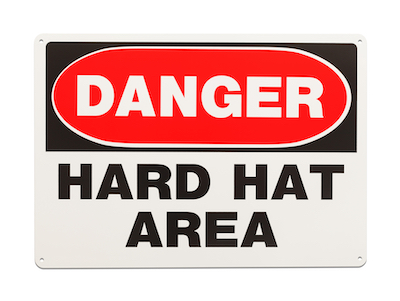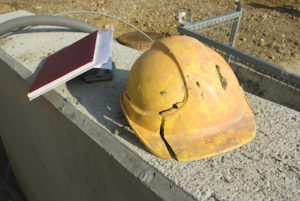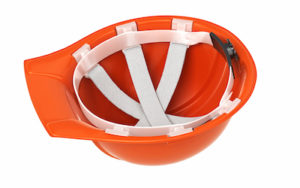HEAD PROTECTION SELECTION & CARE

OSHA 29 CFR 1910.135 (OSHA standard related to head protection)
Injuries to the brain can be life-threatening. Normally, the skull protects your brain from damage, but even as one of the least deformable structures found in nature, it has its limits. The force of a golf ball hitting your head at moderate speed or simply walking into a hard object can fracture your skull. A stronger force can cause more severe injuries. Since head injuries can be very serious, even deadly, head protection is required on certain kinds of jobs.
Head injuries can be caused by falling or flying objects – falling onto or walking into hard objects can also cause serious head injuries. Head injuries can include scalp lacerations, neck sprains, concussions, skull fractures, brain damage or even death.
Most hard hats provide protection from impact or penetration only. They provide protection by adding a rigid shell that resists and deflects blows to the head, with an inside suspension system that acts as a shock absorber. They also help shield your scalp, face, neck and shoulders against overhead splashes, spills and drips of hot or caustic liquids. Some hard hats are designed to protect from lateral impact as well as top impact, and some have a full brim for rain protection.
Certain types of hard hats, worn by electrical workers, can serve as insulators against electrical shocks. This special type provides both impact protection and protection from either high- or low-voltage electricity. Electrically insulating hard hats are labeled Class E or Class G.
Where and When Must a Hard Hat be Required?
- Any worksite where you are potentially exposed to flying or falling objects.
- Around or under scaffolds or other overhead structures.
- Any demolition work with overhead hazards.
- All logging operations.
- While working as a flagger.
- While working near live electrical conductors that could contact your head.
- Any other locations required by company policy.
As an employer it is important to select the correct hard hat for your employees, to provide employees with hard hats and to instruct employees about where hard hats are required.
Types and Classes of Hard Hats
- Type 1: Helmets intended to reduce the force of impact resulting in a blow only to the top of the head.
- Type 2: Helmets intended to reduce the force of impact resulting in a blow to the top and the side of the head.
- Class E (formerly Class B): Helmets for use where electrical hazards are present (such as in utility services) are nonconducting, intended to protect against falling objects and reduce the danger of exposure to high-voltage electrical shocks and burns. This class offers the highest protection with high-voltage shock and burn protection up to 20,000 volts.
- Class G (formerly Class A): General use (limited voltage – nonconducting) intended to protect against falling objects and reduce the danger of exposure to low-voltage electrical conductors. They provide impact and penetration resistance as well as protection from up to 2,200 volts.
- Class C: These are not tested for electrical resistance. They are designed for lightweight comfort and impact protection and are not intended to provide protection from electrical conductors.
Sizing and Caring for Your Hard Hat
Employers are responsible to ensure that employees know how to properly wear and care for their hard hats. Hard hats must be worn properly to take full advantage of the shock-absorbing suspension system. The suspension inside your hard hat should be adjusted so that the hat sits comfortably but securely on your head. Hard hat headbands and chin and nape straps should be adjusted to keep the hat comfortably on the head. Liners or sweatbands can be added for warmth or cooling.
As with any other PPE, hard hats must be properly cared for. Clean your hard hat as needed to remove oil, grease, chemicals and sweat that can collect in and around your hat. You can clean your hat with mild soap and hot water for 5 – 10 minutes. Rinse with clear water, wipe and let air dry. Because prolonged exposure to sunlight and heat can damage your hat, store it in a clean, dry and cool location out of direct sunlight.
- DON’T use paint, solvents, gasoline, chemicals or harsh cleaning materials on the shell.
- DON’T transport your hard hat in a vehicle’s rear window because sunlight and extreme heat will weaken it.
- DON’T put anything in the space between the suspension system and the shell of the hat.
Replace Your Hard Hat When Needed. Don’t wait!

The shell or other parts of the hat should be replaced when they become damaged. Inspect your hard hat before each use for any visible signs of dents, cracks, gouges, penetration, chalking, loss of gloss or any other signs of damage that might reduce the degree of safety originally provided. Replace the hat when hairline cracks appear or if the hat has been struck by a forceful object, even if no damage is obvious.
Suspensions will deteriorate over time from exposure to sunlight and chemicals, perspiration and hair oils.  Inspect the suspension before every use. Look for cracked, torn or frayed straps. Replace suspension when damage or defects are detected. The normal service life of the suspension is about one year of regular use. The suspension may last longer with intermittent use.
Inspect the suspension before every use. Look for cracked, torn or frayed straps. Replace suspension when damage or defects are detected. The normal service life of the suspension is about one year of regular use. The suspension may last longer with intermittent use.
To protect your head, make sure you have the right hard hat for the job and job site at hand. Wear and care for your hard hat properly and remember to replace it when necessary.
 Report an Injury
Report an Injury Get Coverage
Get Coverage Manage Policy
Manage Policy Pay Bill
Pay Bill
